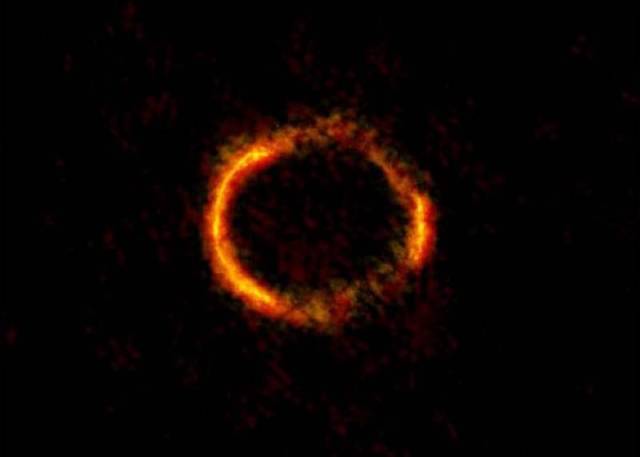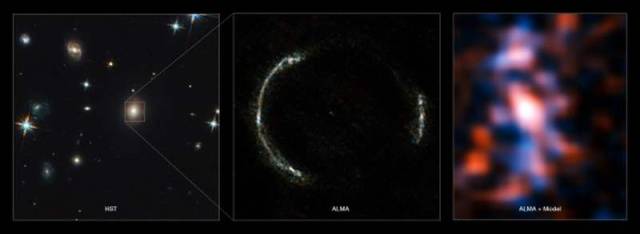Astronomers “weigh” a Black Hole in the center of a Galaxy by studying the Einstein ring phenomenon.
Astronomers at the Institute of Astronomy and Astrophysics (ASIAA), have recently analyzed the highest-ever resolution images of SDP.81, a gravitational lens, taken by the Atacama Large Millimeter/submillimeter Array (ALMA) in Chile.
Above: ALMA image of the gravitational lens system SDP.81. The bright orange sections of the ring reveals the glowing dust in this distant galaxy. The fainter lower-resolution portions of the ring trace the millimeter wavelength light emitted by carbon monoxide. Forming an Einstein ring is a rare phenomenon. Credit: ALMA (NRAO/ESO/NAOJ); B. Saxton NRAO/AUI/NSF
From observations of this ring-shaped image known as an Einstein Ring (a result of the gravitational lensing effect), the team (Postdoctoral Fellow Dr. Kenneth Wong, Assistant Research Fellow Dr. Sherry Suyu and Associate Research Fellow Dr. Satoki Matsushita), calculated that the supermassive black hole located near the center of the lensing galaxy may contain over 300 million times the mass of the sun.
The left panel shows the foreground lensing galaxy (observed with Hubble), and the gravitational lens system SDP.81, which forms an almost perfect Einstein Ring but is hardly visible. The middle image shows the sharp ALMA image of the Einstein Ring. The foreground lensing galaxy is invisible to ALMA, as it does not emit strong submillimeter-wavelength light. The resulting reconstructed image of the distant galaxy (right) using sophisticated models of the magnifying gravitational lens reveals fine structures within the ring that have never been seen before: several giant clouds of dust and cold molecular gas, which are the birthplaces of stars and planets. Credit: ALMA (NRAO/ESO/NAOJ)/Y. Tamura (The University of Tokyo)/Mark Swinbank (Durham University).
Measuring the masses of more distant black holes is the key to understanding the formation and evolution of black holes and their host galaxies. This study marks a new era of research using ALMA and its unparalleled capability for cutting-edge scientific endeavors.
The research was published in The Astrophysical Journal on September 28, 2015
source ASIAA







Leave A Comment